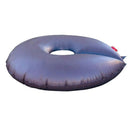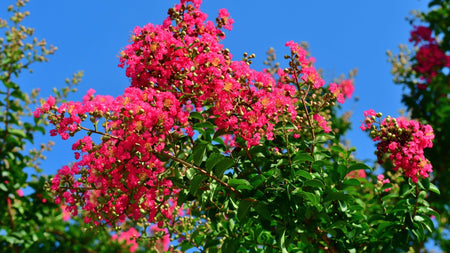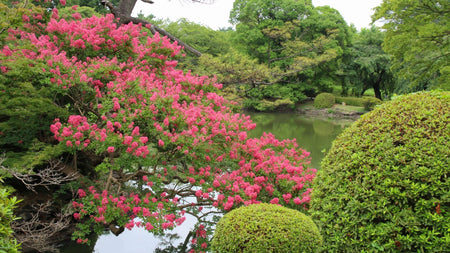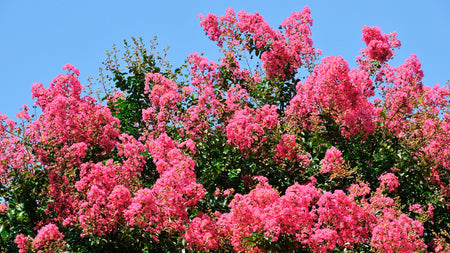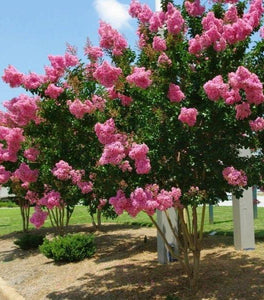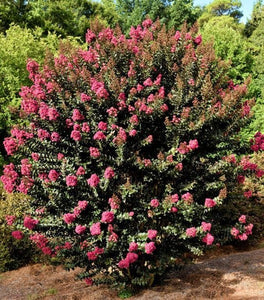
Images Depict Mature Plants
Princess Zoey Crape Myrtle
Princess Zoey Crape Myrtle is a dazzling, compact variety that brings vivid color and easy care to any garden space. Boasting brilliant pink blooms that blanket the shrub from midsummer into fall, Princess Zoey is a true showstopper for small gardens, patios, or landscape borders. Its lush green foliage provides a perfect backdrop for the vibrant flowers, creating a lively and eye-catching display all season long. Reaching a mature height of just 3 to 5 feet, Princess Zoey Crape Myrtle is ideal for gardeners looking for a low-maintenance, dwarf-sized option that delivers big visual impact without overwhelming the space.
Highly adaptable and versatile, Princess Zoey Crape Myrtle thrives in full sun and well-draining soil, offering exceptional drought tolerance once established. This resilient shrub is not only beautiful but also highly disease-resistant, helping to ensure healthy foliage and abundant blooms year after year. Princess Zoey’s naturally compact form requires minimal pruning, making it an excellent choice for foundation plantings, mixed borders, or decorative containers. Whether used as a focal point or mass-planted for a stunning sweep of color, this charming Crape Myrtle variety adds a cheerful touch to any sunny landscape.
In addition to its vibrant aesthetic appeal, Princess Zoey Crape Myrtle is also a magnet for pollinators, drawing bees and butterflies with its rich nectar. Its extended bloom time provides essential food sources for pollinators throughout the hottest months of the year, supporting a healthier garden ecosystem. Easy to grow, deer-resistant, and packed with flower power, Princess Zoey Crape Myrtle is the perfect solution for gardeners seeking reliable color, compact growth, and environmental benefits all in one spectacular package.

| Hardiness Zone: | 6-9 |
|---|---|
| Mature Height: | 4 to 5 feet |
| Mature Width: | 3 to 4 feet |
| Classification: | Mid-sized bush form |
| Sunlight: | Full Sun |
| Habit: | Deciduous, densely branched, multi-stemmed summer through the first frost. |
| Flower Color: | Red and Pink flowers in mid to late summer through the first frost. |
| Foliage: | New growth emerges a rich dark green, changing to an equally vibrant reddish yellow in the fall. |
| Soil Condition: | Any well drained soil |
| Water Requirements: | Water well until established. |
| Uses: | Extremely attractive when used as a focal point in the mixed border, mass planting, or a specimen planting . Small enough to be used for a large containers on the patio. |
How to Care for Princess Zoey Crape Myrtle
Before you buy a Princess Zoey Crape Myrtle, make sure to read about the care instructions that are recommended to keep this plant healthy and thriving.
How do I Plant My Princess Zoey Crape Myrtle?
To plant your Princess Zoey Crape Myrtle, choose a location that receives full sun for at least six hours a day to ensure the best flowering performance. Dig a hole twice as wide as the root ball and just as deep, loosening the surrounding soil to help the roots establish easily. Place the plant in the center of the hole, making sure the top of the root ball is level with or slightly above the surrounding soil. Backfill with a mix of native soil and organic matter, gently firming the soil around the roots to eliminate air pockets. Water thoroughly after planting to settle the soil, and apply a 2-3 inch layer of mulch around the base to retain moisture and suppress weeds. When planting Princess Zoey Crape Myrtle, it’s important to provide proper spacing, especially if you're planting multiple shrubs for a colorful mass display. Space each plant about 3 to 5 feet apart to allow for healthy airflow and growth. Because Princess Zoey is a compact, dwarf variety, it’s also a great candidate for planting in large containers using a high-quality, well-draining potting mix. Be sure to water consistently during the first growing season to help the roots establish, especially during hot, dry weather. With the right planting steps, your Princess Zoey Crape Myrtle will reward you with vivid blooms and easy-care beauty for years to come.
How do I Water My Princess Zoey Crape Myrtle?
When watering your Princess Zoey Crape Myrtle, focus on providing deep, thorough soakings rather than frequent, shallow watering. During the first growing season, water your Princess Zoey once or twice a week, depending on rainfall and temperature, ensuring the soil is moist but not waterlogged. Always water at the base of the plant to keep the foliage dry and reduce the risk of fungal diseases. Deep watering encourages a strong, deep root system, helping your Princess Zoey Crape Myrtle become more drought-tolerant as it matures. Once established, Princess Zoey Crape Myrtle is fairly drought-resistant and typically only needs supplemental watering during extended dry periods. Always check the soil moisture a few inches below the surface before watering; if it feels dry, it’s time to water. Adding a layer of mulch around the base will help retain moisture, regulate soil temperature, and reduce the frequency of watering. Proper watering practices will keep your Princess Zoey Crape Myrtle healthy, vibrant, and covered in stunning pink blooms all summer long.
How do I Fertilize My Princess Zoey Crape Myrtle?
To fertilize your Princess Zoey Crape Myrtle, apply a balanced, slow-release fertilizer, such as a 10-10-10 formula, in early spring just as new growth begins. Spread the fertilizer evenly around the root zone, keeping it a few inches away from the base of the plant, and water it in thoroughly to help the nutrients penetrate the soil. Fertilizing at the right time boosts strong new growth and encourages Princess Zoey’s vibrant pink blooms to flourish throughout the summer. Avoid using high-nitrogen fertilizers, as they can cause excessive leafy growth at the expense of flower production. For best results, you can give your Princess Zoey Crape Myrtle a light second feeding in midsummer, especially if you notice reduced blooming or slower growth. Organic options like compost or well-aged manure can also be worked into the soil around the shrub to enrich it naturally. Always follow fertilizer package instructions carefully to prevent overfeeding, which can stress the plant. With a consistent fertilization routine, your Princess Zoey Crape Myrtle will remain healthy, colorful, and full of life, brightening your landscape season after season.

How and When Should I Prune My Princess Zoey Crape Myrtle?
You should prune your Princess Zoey Crape Myrtle in late winter or very early spring, before new growth starts to appear. This timing allows you to clearly see the shrub’s structure and shape it without removing any developing flower buds. Begin by removing any dead, damaged, or crossing branches to promote healthy growth and improve air circulation. Because Princess Zoey is a naturally compact and well-behaved variety, only light pruning is usually necessary to maintain its rounded form and encourage more vigorous blooming throughout the summer. When pruning your Princess Zoey Crape Myrtle, avoid the common mistake of severely cutting back the branches, often called "crape murder." Instead, focus on selective thinning and shaping to preserve the plant’s natural beauty and maximize flower production. You can also lightly deadhead spent blooms during the growing season to encourage a second flush of vibrant pink flowers. Proper pruning not only keeps Princess Zoey looking tidy and healthy but also ensures a long season of dazzling color in your garden or container plantings.



